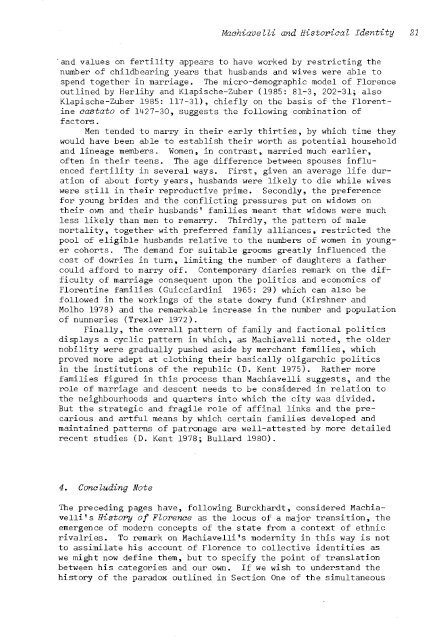CONTENTS NO.I - Institute of Social and Cultural Anthropology ...
CONTENTS NO.I - Institute of Social and Cultural Anthropology ...
CONTENTS NO.I - Institute of Social and Cultural Anthropology ...
Create successful ePaper yourself
Turn your PDF publications into a flip-book with our unique Google optimized e-Paper software.
Machiavelli <strong>and</strong> Historical Identity 21<br />
'<strong>and</strong> values on<br />
appears to have worked by restricting the<br />
number <strong>of</strong> childbearing years that husb<strong>and</strong>s ~nd wives were able to<br />
spend in The micro-demographic model <strong>of</strong> Florence<br />
outlined by Herlihy <strong>and</strong> Klapische-Zuber (1985: 81-3, 202-31; also<br />
Klapische-Zuber 1985: 117-31), chiefly on the basis <strong>of</strong> the Florentine<br />
castato <strong>of</strong> 1427-30, suggests the following combination <strong>of</strong><br />
factors.<br />
Men tended to marry in their early thirties, by which time<br />
would have been able to establish their worth as potential household<br />
<strong>and</strong> lineage members. Women, in contrast, married much earlier,<br />
<strong>of</strong>ten in their teens. The age difference between spouses influenced<br />
fertility in several ways. First, given an average life duration<br />
<strong>of</strong> about forty years, husb<strong>and</strong>s were likely to die while wives<br />
were still in their reproductive prime. Secondly, the preference<br />
for young brides <strong>and</strong> the conflicting pressures put on widows on<br />
their own <strong>and</strong> their husb<strong>and</strong>s' families meant that widows were much<br />
less likely than men to remarry. Thirdly, the pattern <strong>of</strong> male<br />
mortality, together with preferred family alliances, restricted the<br />
pool <strong>of</strong> eligible husb<strong>and</strong>s relative to the numbers <strong>of</strong> women in younger<br />
cohorts. The dem<strong>and</strong> for suitable grooms greatly influenced the<br />
cost <strong>of</strong> dowries in turn, the number <strong>of</strong> daughters a father<br />
could afford to marry <strong>of</strong>f. Contemporary diaries remark on the difficulty<br />
<strong>of</strong> marriage consequent upon the<br />
<strong>and</strong> economics <strong>of</strong><br />
Florentine families (Guicciardini 1965: 29) which can also be<br />
followed in the workings <strong>of</strong> the state dowry fund (Kirshner <strong>and</strong><br />
Molho 1978) <strong>and</strong> the remarkable increase in the number <strong>and</strong> population<br />
<strong>of</strong> nunneries (Trexler 1972).<br />
, the overall pattern <strong>of</strong> family <strong>and</strong> factional politics<br />
displays a cyclic pattern in which, as Machiavelli noted, the older<br />
nobility were gradually pushed aside by merchant families, which<br />
proved more adept at clothing their basically oligarchic politics<br />
in the institutions <strong>of</strong> the republic (D. Kent 1975). Rather more<br />
families figured in this process than Machiavelli suggests, <strong>and</strong> the<br />
role <strong>of</strong> marriage <strong>and</strong> descent needs to be considered in relation to<br />
the neighbourhoods <strong>and</strong> quarters into which the city was divided.<br />
But the strategic <strong>and</strong> fragile role <strong>of</strong> affinal links <strong>and</strong> the precarious<br />
<strong>and</strong> artful means by which certain families developed <strong>and</strong><br />
maintained patterns <strong>of</strong> patronage are well-attested by more detailed<br />
recent studies (D. Kent 1978; Bullard 1980).<br />
4. Concluding Note<br />
The preceding pages have, following Burckhardt, considered Machiavelli's<br />
History <strong>of</strong> Florence as the locus <strong>of</strong> a major transition, the<br />
emergence <strong>of</strong> modern concepts <strong>of</strong> the state from a context <strong>of</strong> ethnic<br />
rivalries. To remark on Machiavelli's modernity in this way is not<br />
to assimilate his account <strong>of</strong> Florence to collective identities as<br />
we might now define them, but to specify the point <strong>of</strong> translation<br />
between his categories <strong>and</strong> our own. If we wish to underst<strong>and</strong> the<br />
history <strong>of</strong> the paradox outlined in Section One <strong>of</strong> the simultaneous

















